|
HIGHWAY Markings
Pavement AND CURB
markings-PURPOSE AND MEANING
Lines and other markings painted on the pavement are also used
to control and direct traffic. Sometimes these lines will include reflective
raised pavement markers which make the lines more visible, or the markers may be
used to simulate the lines. Yellow and white are the two most common colors of
pavement markings. Lines in these two colors have different meanings. You should
be able to determine where you are on a roadway by the color and type of the
lines.
Yellow center line
marking
Yellow lines parallel to the roadway mark the center of a
roadway on which there is two way traffic. Yellow lines are used in different
configurations that have different meanings.
Yellow line
markings, broken
If there is a single yellow line dividing lanes of traffic, and
the line is broken (not continuous), you may pass over this to pass other
vehicles, and to make left turns into other streets, driveways, and alleys if it
can be done safely.
Yellow line
markings, solid
If there is a single solid yellow line dividing lanes of
traffic, you may not drive over this line to pass other vehicles. You may cross
over a solid yellow line to make a left turn at an intersection, to enter or
exit a road or a driveway, or to make a U-turn, if it can be made safely and is
not otherwise prohibited.
On divided highways and some other roadways, a single solid
yellow line will usually be used to indicate the leftmost boundary of the
drivable roadway. You should not drive to the left of this line. Sets of solid
yellow lines are frequently used to divide oncoming lanes of traffic before an
upcoming hazard such as a road obstruction caused by the pillar of an
over-crossing.
Yellow line markings, solid line next to a broken line
If there are two yellow
lines dividing lanes of traffic, and the line closest to your lane is broken,
you may cross over it to pass vehicles ahead, if it is safe to do so. If the
line closest to your lane is solid, you may not cross over it except to turn
left into a driveway or alley.
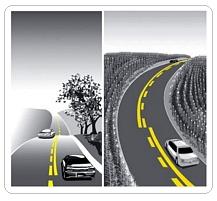
Double solid yellow lines on two lane roadways
If there are two solid yellow lines dividing lanes of traffic,
you may not cross over them to pass another vehicle. You should never drive to
the left of these lines.
You may cross over a
double solid yellow line to make a left turn at an intersection, to enter or
exit a road or a driveway, or to make a U-turn, if it can be made safely and is
not otherwise prohibited.
If the road has only two lanes, one lane in each direction, a
slow-moving vehicle must pull into a turnout lane if five
or more vehicles are trailing.
Double solid yellow lines on four lane roadways
If there are four lanes, two lanes in each direction, driver on the first lane
(the most right lane). Use the left lane for passing only. Do not cross
over solid yellow lines to pass another vehicle.
Two sets of solid double
yellow lines that are two or more feet apart represent a wall or center divider.
You may not drive on or over these lines for any reason. You may only make a U
turn or left turn on a street divided with these lines at an opening provided
for turns.
In some cases, one or more
sets of parallel solid yellow lines are also used to separate carpool lanes from
normal traffic lanes. Do not cross over these lines to enter or exit the carpool
lane. Wait until the lines are broken or for some other designated place to
enter or exit the lane.
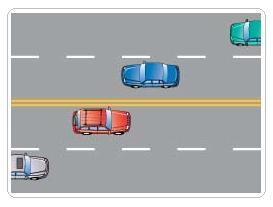
Yellow line markings, center left turn lanes
A center traffic lane
enclosed by double yellow lines on each side with the inner lines broken may be
used to start and complete left hand turns and start U-turns from either
direction of traffic, but cannot be used for passing. The rules for proper use
of center left turn lanes is frequently misunderstood by drivers.
You must use the center
left turn lane to make a left turn or U turn if one exists on the street you are
driving. You must signal and completely enter the lane before making your
left-hand turn. Don't stop part way into the lane, with your vehicle blocking
traffic.
You may only drive in this
lane for a distance up to 200 feet, which is about the length of five or six
vehicles. The limit on driving in a center left turn lane is to help prevent
drivers from using this lane as a regular traffic lane or as a passing lane. You
may not use a center left-turn lane for either of these purposes.
Be careful to look for
vehicles coming from the opposite direction that are pulling into a center left
turn lane. Because of the potential for meeting other vehicles coming from
opposite direction head-on, center left turn lanes are often referred to as
"suicide lanes."
When turning left from a
side street or driveway, you have the option to use this lane before completing
your turn. If you want to first turn into the center left-turn lane, you should
signal, wait until it is safe, and then drive completely into the center left
turn lane. Wait in the lane with your right-turn signal on for traffic to clear
before pulling into traffic. Alternatively, if traffic is clear in both
directions, you can just make your left turn directly from the side street or
driveway, without first stopping in the center left turn lane.
You may drive across a
center left turn lane to enter a driveway or street that is directly on the
other side. However, you should not use a center left-turn lane to make a right
turn.
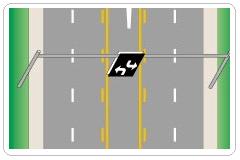
White line markings
White lines parallel to
the roadway separate lanes of traffic going in the same direction, including
bicycle lanes from car lanes. White lines which cross the roadway delineate
crosswalks or limit lines. Messages such as "STOP AHEAD" or arrows directing
traffic in a particular lane are often painted on the pavement in white. White
lines of different configurations indicate different meanings.
White line markings,
broken
If a single broken white
line divides lanes of traffic, you may cross over the line to enter the lane
next to you.
If the lane you are
driving in has a thicker broken white line, then the lane you are in is for
exiting the roadway, merging into other lanes, or is ending. The broken line
will soon become a single solid white line or a set of double solid white lines
which cannot be crossed.
White line markings, solid
A single or double solid
white line dividing traffic lanes going in the same direction cannot be crossed
for any reason.
On divided highways, a
single solid white line will usually be used to indicate the rightmost boundary
of the drivable roadway. You should not drive to the right of this line.
Sets of solid white lines
are frequently used to divide the lanes before an upcoming hazard such as a road
obstruction caused by the pillar of an over-crossing, or the median between a
freeway off-ramp and normal traffic lanes. Again, these lines should not be
crossed.
Thicker solid white
lines are used to separate parts of left and right turn lanes close to the
intersection. If you pass the part of the turn lane that has a broken white line
or no line, you may not turn over the solid line to enter the turn lane.
Lines with arrows
White arrows are sometimes painted on the roadway which indicate
whether the lane proceeds ahead, merges, turns, or exits, and are intended to
guide your choice of lane.
Curb markings
A painted curb means that you must
follow special rules to park there. The curb are color painted in the areas
where parking must be limited or even prohibited. For example, city commercial
areas may reserve some parking spaces for loading and unloading or for
commercial vehicles only. The colors on curbs mean:
-
White:
You may stop only long enough to pick up or drop off passengers or mail.
-
Green:
You may park for a limited time. The time is usually shown on a sign next to
the green zone, or painted on the curb.
-
Yellow:
You may stop here only long enough to load or unload things or peopleóno
longer than the local law allows. Drivers of noncommercial vehicles are
usually required to stay with their vehicle.
-
Red:
No stopping, standing, or parking. (A bus may stop at a red zone marked for
buses.)
-
Blue:
This indicates parking for the disabled only. You must have a placard
(window sign) or your license plates must be specially marked.
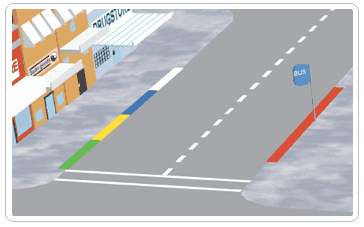
ADDITIONAL PAVEMENT MARKINGS-COLOR AND PURPOSE
Edge of pavement
A single solid white line
will usually be used to indicate the edge of pavement. You should not drive to
the right of this line.
A single solid yellow lines are used on the left
edge of divided streets or roadways.
Obstructions
Upcoming road obstructions may be marked by
crosshatch white or yellow lines painted on the pavements.
Crosshatch lines define an area, within defined boundaries, over which vehicular
traffic should not travel. Crosshatch lines are sloped in the direction of major
flow of traffic.
Stop lines
Thick solid white lines
that cross the roadway are used to mark the stop line at intersections and the
clearance line at RR crossings. You must stop behind these lines when you stop
at an intersection or railroad crossing. The stop lines at railroad crossings
are often preceded by white painted letters on the pavement such as "RXR."
Crosswalks
Crosswalks are delineated with sets of broad white lines which
cross the road. However, crosswalks exist at most intersections where the
roadways meet at approximately 90 degree angles and there is one or more
sidewalks that would continue over the roadway, whether or not there are white
painted lines. This is called an unmarked crosswalk. Crosswalks are often
preceded by white words painted on the road indicating "SLOW PED XING."
There are special
rules you must follow when dealing with pedestrians crossing the roadway, but in
general you should always stop behind the crosswalk when you must stop at an
intersection.
Railroad
crossings
Railroad
crossings
are often marked with solid white lines
across the roadway. They mark where to stop at railroad
crossing.
You must stop behind these lines when you stop
at a railroad crossing. These stop lines at railroad crossings
are often preceded by white painted letters on the pavement such as "RXR."
You must never stop in the
vehicle clearance
area marked by white solid lines and white "X"
symbol .
School warnings
Broad yellow lines crossing the road are sometimes used to
indicate a school crossing. Yellow markings on the pavement which say "SCHOOL
XING" will usually also be painted near school crossings. You should carefully
scan for children about to cross or crossing the road when you see these
markings.
Bike lanes
The purpose of a bike lane is to provide a protected area for
bicyclists so as to reduce the probability of accidents between motor vehicles
and bicycles.
A bicycle lane is marked by a solid white line along either side
of the street that is at least 4 feet from curb. This line will usually be a
broken line near corners of intersections. The words BIKE LANE are painted in
white on the pavement at various locations in this lane.
Bicyclists are required to use bicycle lanes, when they are
present on a roadway. However, they may exit these lanes to pass, make turns, or
avoid a collision.
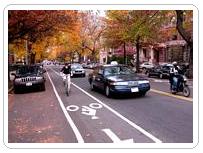
Diamonds lanes
Diamonds painted in a lane
indicate that lane is for use by buses and carpools only. Using a carpool lane
requires a minimum of 2 or 3 people in your vehicle (depending on what is
indicated on the accompanying signs), including the driver.
Carpooling and bus riding are useful ways to save fuel and
reduce the number of vehicles using highways in heavy commute traffic.
Some freeways have special lanes and on-ramps for carpools.
Signs at the on-ramp or along the freeway tell you the size of the carpool
(number of people) needed to use that lane and the days and hours that the
requirement applies. The pavement of these lanes is marked with the diamond
symbol and the words "CARPOOL LANE." Do not cross over the double parallel solid
lines to enter or exit any carpool lane except at designated entry or exit
places.
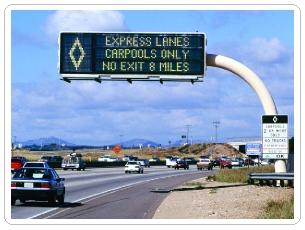
INTERSECTIONS OR CROSSING THAT REQUIRE SPECIAL
STOPS
Railroad crossings
General
When automobiles and trains meet unexpectedly, the result can be
catastrophic. Automobile drivers must understand how to identify railroad
crossings and react to approaching trains. They should understand the tremendous
risk they put themselves in when they try to beat a train to a crossing or drive
around protective crossing gates. Drivers who fail to understand this risk
contribute to the following statistics.
Trains,
accident statistics
In any given year, about 500 people die
and 1,500 are seriously injured in car vs. train collisions.
Over 500 people are killed while
trespassing on railroad tracks and property each year.
A motorist is 30 times more likely to be
killed in a crash involving a train than in a collision involving another motor
vehicle.
More people die in highway-rail collisions
each year than in commercial airline crashes in an average year.
It takes the average train over a mile to
stop.
The majority of vehicle-train crashes
occur when the train is traveling less than 30 miles per hour.
Controls
Signs warn you that you are approaching railroad tracks. Look
and listen for trains in both directions. Be ready to stop, if necessary. You
should expect a train on a track at any time, day or night.
Flashing red lights at a railroad crossing mean STOP!
Stop at least 15 feet from the tracks when:
- A person or signal warns that a train is coming.
- You see a train coming.
Crossing gates -Do not go around or under any closed railroad gate. Cross only
when it is safe. The spate of recent collisions at railroad crossings has
spawned a new penalty. A first railroad grade crossing offense would cost you a
fine of $100, which increases to $200 and $250 for a second and third offense.
The court may also require you to attend a traffic school.
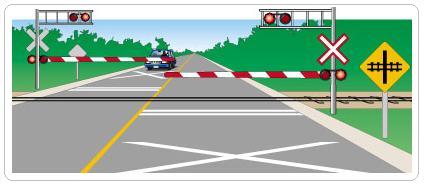
You hear the horn or bell of a train close by. Never start across if there isn't room for your vehicle on the
other side of the tracks. Don't go ahead until you can see clearly in both
directions because there may be a second train coming from either direction .
This Circular sign
mean you are approaching a railroad crossing.
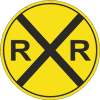
Railroad crossing Safety
Never stop on a railroad track. When traffic is heavy,
wait off the tracks until you are sure you can drive over them without stopping.
Watch for vehicles that must stop before crossing the tracks,
such as buses, school buses, and large trucks transporting hazardous loads.
Never walk on railroad tracks.
When crossing multiple tracks, wait a few
seconds after a train has passed to be sure there isn't one traveling the other
way.
Never race a train to the crossing.
If your vehicle stalls on a railroad crossing, get everyone out
and off the tracks immediately. If no train is in sight, post lookouts and
try to start the vehicle from outside or push it off the tracks.
Don't misjudge a train's speed and distance. Because of the
large size of trains and the viewing angle at which you see them, they appear to
move much slower than you think. If you have any doubts, stop and wait for the
train to pass.
School Busses
Flashing red
lights
You may come upon a school bus which is stopped
and flashing yellow lights. This is a warning for you to prepare to stop because
the children are preparing to leave the bus.
When you come upon a school bus stopped on either side of the
road with flashing red lights, you must stop. The flashing red lights are
located at the top front and top back of the bus. School children will be
crowding the road to or from the school bus. Remain stopped as long as the red
lights are flashing.
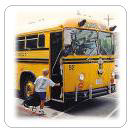
- School busses are now required to activate red
lights at all stops.
- Always obey hand signals and other
instructions of school bus drivers.
- Be as courteous as possible to school busses
and give them the right of way whenever possible.
- Do not pull out in front of school busses or
otherwise cause them to maneuver abruptly.
- Be very cautious around stopped school busses,
even if the red lights are not flashing. Assume that child might dart out in
front of you.
|
 Content
Of Online Course
Content
Of Online Course







